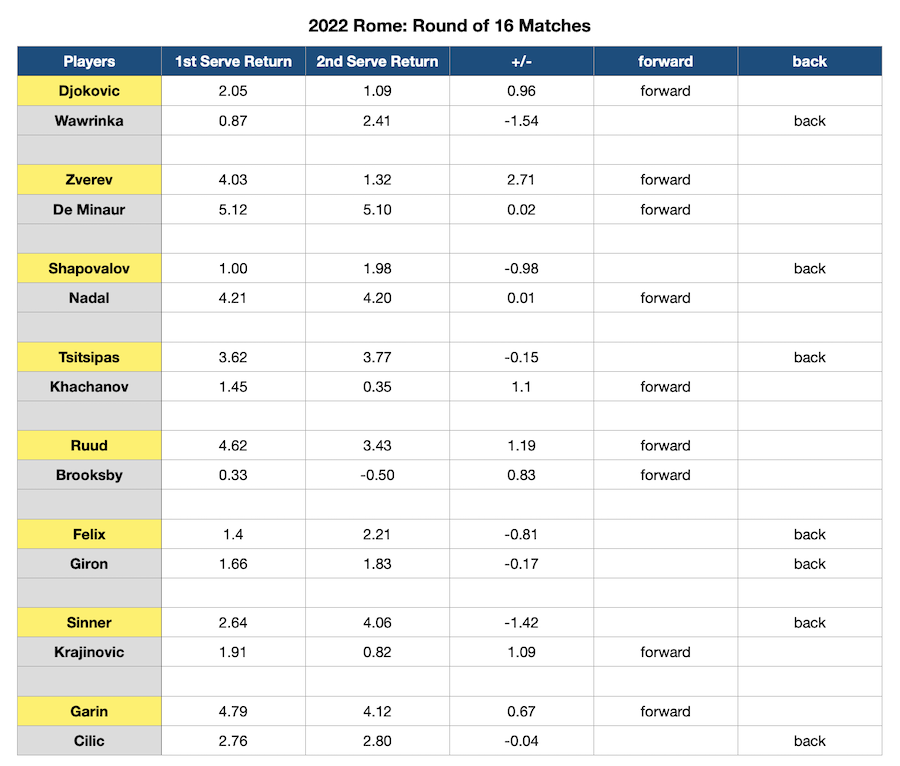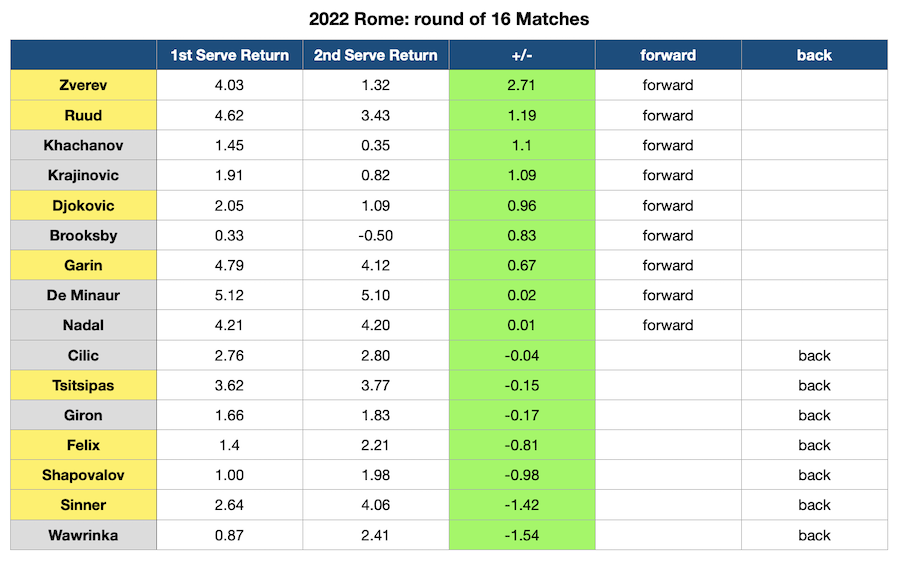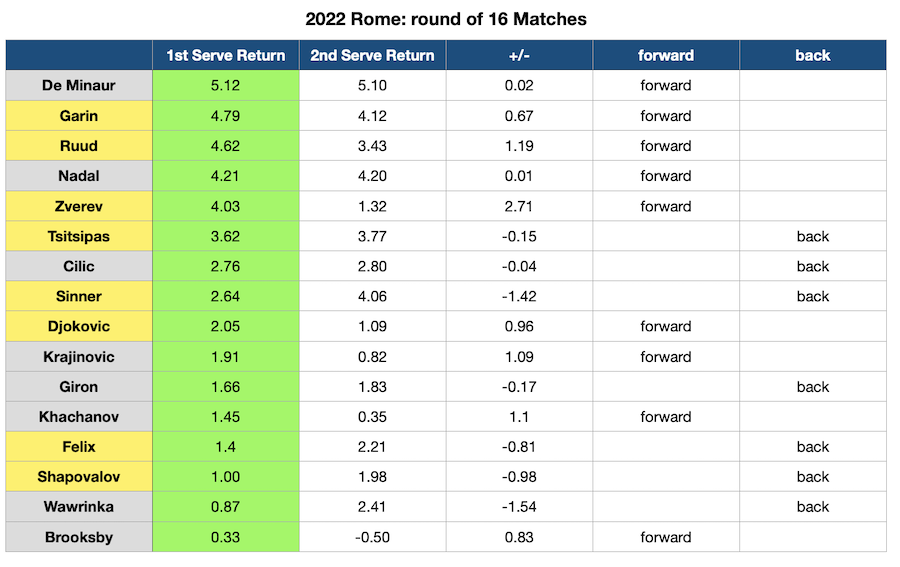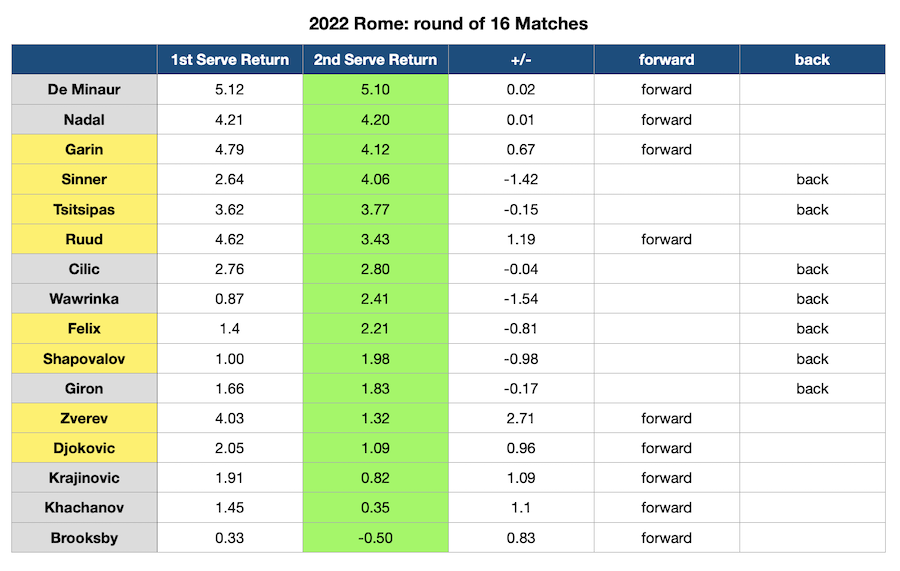G’day from Roma,
You can break down what happens in a tennis match into four simple categories.
- Serving
- Returning
- Rallying
- Approaching
Different players are going to employ different strategies, but in general, you are going to find minor variations in the patterns of play because players know what works and what doesn’t from playing hundreds of thousands of points. That’s what has brought them this far in their career. For example, forehands dominate backhands, and errors occur more than twice the amount as winners.
In general, we have a good idea of what we are watching. When a ball is hit down the middle of the court to a player’s backhand, and they quickly move around it to upgrade to a run-around forehand, we understand why. A forehand is a bigger weapon. More power, more chance to inflict pain.
This brings us to returning serve. Specifically, where a player stands to return 1st and 2nd serves here in Rome in the Round of 16. Here are the results from the round of 16:
- Novak Djokovic def. Stan Wawrinka 6-2, 6-2
- Alexander Zverev def. Alex De Minaur 6-3, 7-6(5)
- Denis Shapovalov def. Rafael Nadal 1-6, 7-5, 6-2
- Stefanos Tsitsipas def. Karen Khachanov 4-6, 6-0, 6-3
- Casper Ruud def. Jenson Brooksby 6-3, 6-4
- Felix Auger-Aliassime def. Marcos Giron 6-3, 6-2
- Jannik Sinner Filip Krajinovic 6-2, 7-6(6)
- Christian Garin def. Marin Cilic 6-3, 4-6, 6-4
The universal truth of staying back a little further to return 1st serves and stepping forward more to hit 2nd serves has been thrown out the proverbial window. Who knows what players are thinking because the variation is so big. The accepted norm is that you stand back against a harder first serve to be able to better deal with the power. And then you step in vs. a slower second serve and really go after it.
The Rome 2022 Round of 16 data set is below. The numbers are in meters, and the players in yellow were the match winners.

Let’s examine three data points to grasp what players were trying to achieve based on their return position.
1: Do Players Actually Step Further Forward vs. 2nd Serves?
Yes, and no.
Nine players out of 16 made contact with the ball further up into the court against 2nd serves compared to 1st serves. That leaves seven players who purposely moved back against a slower 2nd serve. Basically, half the data set thought they would win more stepping back than stepping in. That flies in the face of conventional wisdom.
When you analyze the eight match winners, half (4) were in the moving forward group, and the other half were in the moving back group. Dead even. Very difficult to draw any solid conclusions there.
Alexander Zverev moved forward the most between 1st and 2nd serves. He made contact with 2nd serves 2.71 meters further forward than the first serve. Ruud (1.19m), Khachanov (1.10m), and Krajinovic (1.09m) were the other players to move forward more than a meter between the two serves.

Wawrinka was the player that moved back the most, making contact 1.54 meters further back on average when contacting his 2nd serve versus the first serve. Sinner was the other player to move back more than a meter at 1.42m.
1st Serve Return Contact Point
There is a massive difference in how far back players contact the 1st serve. De Minaur was more than five meters behind the baseline to return first serves against Zverev, while Brooksby and Wawrinka were within a meter of the baseline returning first serves.

There is clearly no wrong or right here, as once again, the yellow cells (match winners) are evenly spread through the data set.
2nd Serve Return Contact Point
Brooksby was the only player in the Round of 16 that averaged making contact with the ball inside the baseline. His average was half a meter inside the baseline. He was one of seven players whose average was within two meters of the baseline, taking the ball early vs. 2nd serves.

The range is greater than five metres with where players stand to return 2nd serves. It’s basically all over the shop!
Summary
So the first thing to contemplate is why there is so much variation in where players stand to return. And then the focus is also on comparing 2nd serve returns versus 1st serve returns? Here are three points to consider:
- Players that stand up in the court vs. 2nd serves are primarily trying to take time away from the server and get the ball back to them quickly, forcing a Serve +1 error. They like their chances to make a lot of returns and immediately hurt the opponent and extract the early error.
- A player such as De Minaur stands way back, basically saying he is not going to miss a return all day long. Everything is coming back into play. And then he has the wheels to run everything down if he does return short and his opponent is on offense.
- Also, consider the opponent. Do they like to use power in a Serve +1 situation, low and hard in their strike zone? Or is it better to hit the ball higher and heavier and deeper from further away, making it potentially more difficult to get the right timing. If the opponent is strong defensively and weaker offensively – especially against a slower, higher ball – then standing back, and looping makes sense.
I hope this analysis helps you reflect on your own game. It might be a good idea to experiment standing up on some second serves and standing back on others. Play around with it against different opponents and evaluate your results!
All the best,
Craig

